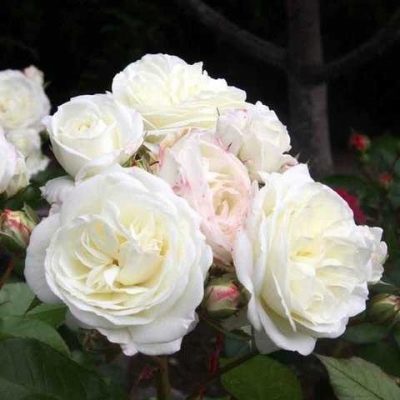
- Authors: Evers
- Name synonyms: Alabaster
- Breeding year: 2007
- Group: floribunda
- The main color of the flower: white
- Flower shape: cupped
- Flower size: large
- Diameter, cm: 8-9
- Flower type by number of petals: thick double
- Description of the bush: compact
Rose Alabaster was bred in Germany as a result of selection in 2007. The flower also has another name, Alabaster. This rose belongs to the floribunda group.
Description of the variety
Rose Alabaster has a spherical shape. Her colors are usually soft cream. The bush is quite sprawling, powerful and tall.
The variety boasts a high resistance to frost, to sudden temperature changes, so it easily and quickly takes root in regions with a temperate climate. Rose Alabaster also has good resistance to various diseases.
Advantages and disadvantages
Among the advantages of this flower should be highlighted unpretentiousness when leaving, cold resistance, resistance to various infections, including fungal. Separately, it should be noted the special decorativeness of the flower. The rose has very beautiful and lush flowers.
But sometimes various pests can appear on the flower, including aphids. If you do not start timely treatment, the leaves will begin to dry out and fall off. Among the shortcomings, one can also highlight a change in the color of the buds. Over time, flowers with a dark "dirty" shade may appear on mature bushes.
Flowering features
Rose Alabaster begins to bloom with the formation of dense buds. From them in the future, flowers of a soft cream color bloom. Sometimes a slight green tint can be observed on young flowers. As a rule, 3-5 flowers bloom on one healthy stem.
Sometimes in the process of flowering, one large bud and several small inflorescences are formed on the sides. On average, the diameter of each rose in full bloom is 8-10 centimeters.
A large number of small petals of a dark green color are located on the stems. Against their background, light flowers look even more lush and voluminous. Sometimes during flowering, small blotches of bright red appear on the surface of the petals.
Roses of this species have a pleasant, slightly perceptible aroma. During the season, the species blooms twice. But with proper care, later flowering can be achieved.
As a rule, this variety blooms very profusely. Flowers are able to persist for a long time. Alabaster is perfect for both large and compact flower arrangements on the site.
Landing
Most often, planting is performed in the spring (April-May). Sometimes a rose is planted in the autumn season, but in a short time, otherwise the vegetation simply will not have time to take root. Keep in mind that the planting density should be 3-5 pieces per 1 m2 of territory.
It is better to prepare the seats in advance. For such roses, pits are dug with a depth of at least 60 cm. Good drainage (a layer of at least 10 cm) and fertilizers must be placed at the bottom of each hole. Only after that the rose is planted.
Growing and care
Rose Alabaster is best grown in lighted areas or in partial shade. Fertile, light and breathable soil is suitable for her. After planting, the plant needs regular watering. In dry and hot weather, twice a week will be enough. Each bush should have 15-20 liters of cold water.
In addition, the flower will also need fertilizer. For such a rose, fertilizing with nitrogen and with phosphorus, potassium will be the best option.The former are used in the spring and the latter in the summer.
In the process of growth, the rose will need to be pruned (sanitary and formative pruning will be needed). Although the vegetation is frost-resistant, it should still be prepared for the winter season. To do this, you can build a protective frame of spruce branches and foliage around the bushes.
Diseases and pests
The rose of this variety is considered quite resistant to diseases, including powdery mildew, black spot. If, nevertheless, the vegetation got sick with fungal infections, then medical treatments are carried out with drugs, which contain copper. All affected parts are pre-cut from the bushes and burned.
Rose Alabaster has medium pest resistance. Colonies of green aphids can appear on it, most often the parasite infects young foliage. And also a spider mite, a rosy leafworm, an unpaired silkworm, a rosy scale insect sometimes settle on a flower.
Harmful insects actively feed on plant juices, which gradually dry up and die. To get rid of such pests, organophosphates should be used. And also in this case, drugs of systemic action are suitable, these include, among other things, "Fufanon", "Aktara".
Reproduction
Rose Alabaster can propagate by cuttings. It is only with vegetative propagation that vegetation is able to retain all its varietal characteristics. Cuttings must be taken from young, but healthy and strong bushes. This is done after the first wave of flowering.
Review overview
Most gardeners spoke positively about roses of this variety. It was noted that the flower has an amazing cold resistance, it wakes up easily after the winter season.
A rose in the process of its development practically does not get sick with anything. In addition, it is able to bloom profusely continuously. Some have noticed that such a garden flower has a good mass. Its width can be up to 1.5 m.
But some gardeners also left negative reviews. So, it was noted that over time, flowers of a different, darker color begin to form on adult bushes, which can spoil the decorative appearance of the plant.































































